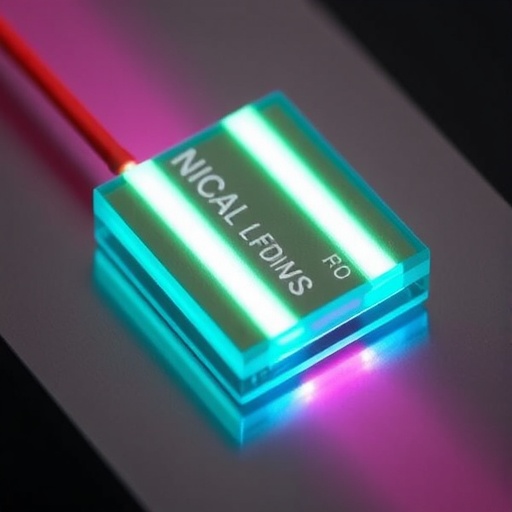In an impressive advancement within the field of energy storage, new research has unveiled the capabilities of a self-activated electrode made from a unique hybrid of materials known as NiCoAl-Layered Double Hydroxides (LDH) anchored on Graphene Oxide (GO) and Graphene Oxide Nanoribbons (GONRs). The study, led by researchers Hamad, Baqer, and Abbas, reveals that this innovative electrode design can deliver a capacitance gain exceeding 800% during prolonged cycling tests. Such an achievement represents a significant leap forward in the quest for ultra-efficient energy storage solutions, vital for a range of applications from portable electronics to electric vehicles.
Layered Double Hydroxides (LDHs) have emerged in recent years as promising materials for energy devices owing to their remarkable electrochemical properties. Their structure allows for high ion intercalation, which is critical for achieving enhanced charge storage capabilities. In this latest work, the team utilized NiCoAl-LDH, leveraging its intrinsic capability to enhance conductivity and electrochemical activity when combined with graphene-based materials. This synergy is crucial for producing an electrode that not only operates efficiently but also maintains stability over extensive operational periods.
The integration of Graphene Oxide and Graphene Oxide Nanoribbons into the electrode matrix plays a pivotal role in enhancing conductivity and structural integrity. Graphene Oxide is renowned for its excellent conductivity, mechanical strength, and large surface area, which collectively contribute to improving the performance of electrochemical devices. By incorporating GONRs, the research team effectively increased the conductive pathways within the electrode, further bolstering its energy storage potential.
One of the standout features of this study is the impressive capacitance gain observed during long-term cycling. The research provides convincing evidence that the NiCoAl-LDH@GO/GONRs electrode can sustain its performance over prolonged charge and discharge cycles, which is often a significant challenge in traditional energy storage systems. With over 800% capacitance gain reported, it indicates not only a remarkable efficiency in energy storage but also an extended lifespan when subjected to continuous usage.
Moreover, the self-activated mechanism of this electrode configuration is garnering attention among scientists and engineers alike. This characteristic reduces the need for external activation processes often required by conventional electrodes. Researchers theorize that the self-activation could arise from structural changes during cycling that enhance ion transport, thereby facilitating an electrochemical response that is both rapid and efficient. Such a feature could lead to more streamlined manufacturing and operational protocols in future energy storage devices.
In addition to its high performance, the findings emphasize the material’s sustainability and scalability. The components making up the NiCoAl-LDH@GO/GONRs electrode can be synthesized using relatively accessible raw materials, posing an advantage in terms of cost-effectiveness and environmental impact. This is an essential consideration as the world moves toward greener technologies and sustainable energy solutions.
As the demand for energy storage systems grows, particularly with the rise of renewable energy sources, the development of materials like the NiCoAl-LDH@GO/GONRs electrode becomes increasingly relevant. High-capacity storage solutions are paramount for balancing supply and demand, especially when integrating intermittent energy sources such as solar and wind power into the grid. The research team’s results could play a transformative role in shaping the future of battery technology and beyond.
The breakthrough observed in this study also highlights the growing trend of hybrid materials in scientific research. By merging different types of materials, researchers can exploit the individual advantages each offers, leading to enhanced performance in practical applications. As demonstrated by the NiCoAl-LDH@GO/GONRs electrode, exploring combinations of materials opens the door to innovations that could redefine energy storage.
Looking ahead, further research will be crucial to unlock the full potential of this electrode design. Investigating different layering techniques and adjusting the composition of the hybrid materials could lead to even greater improvements in performance metrics. Additionally, the team suggests that exploring various synthesis methods and conditions might provide insights into optimizing their self-activation mechanisms for enhanced durability and efficiency.
This promising development is also likely to stimulate collaborative efforts among researchers and industries focused on energy storage technologies. As the implications of this study become apparent, a broader dialogue between academia, industry leaders, and policymakers will be essential for translating these findings into real-world applications. The ongoing exploration of advanced electrode materials not only contributes to scientific knowledge but also has significant implications for future energy strategies.
Understanding the intricate mechanisms that contribute to the heightened performance of the NiCoAl-LDH@GO/GONRs electrode will be pivotal for the energy sector. By examining how various factors influence energy storage capabilities, researchers can formulate guidelines for the design and optimization of next-generation electrodes. This will ensure that the journey toward achieving superlative energy storage solutions continues to advance.
In conclusion, the research spearheaded by Hamad, Baqer, and Abbas presents groundbreaking advancements in the realm of energy storage systems. The self-activated NiCoAl-LDH@GO/GONRs electrode’s capacity for significant capacitance gain during long-term cycling is not only an achievement for the scientific community but also a beacon of hope for the future of energy technologies. As the world seeks more sustainable and efficient energy solutions, innovations of this nature will undoubtedly play a fundamental role in our transition toward a cleaner, more sustainable energy future.
Subject of Research: Hybrid materials for energy storage, specifically self-activated electrodes.
Article Title: Self-Activated NiCoAl-LDH@GO/GONRs electrode exhibits over 800% capacitance gain during Long-Term cycling.
Article References:
Hamad, I.A., Baqer, A.A. & Abbas, M.N. Self-Activated NiCoAl-LDH@GO/GONRs electrode exhibits over 800% capacitance gain during Long-Term cycling.
Ionics (2025). https://doi.org/10.1007/s11581-025-06811-2
Image Credits: AI Generated
DOI: 10.1007/s11581-025-06811-2
Keywords: NiCoAl-LDH, Graphene Oxide, Energy Storage, Capacitance Gain, Electrode Technology.
Tags: Capacitance gain in supercapacitorsConductivity enhancement in electrodesElectrochemical properties of LDHsElectrode design for capacitance boostGraphene Oxide for energy storageGraphene Oxide Nanoribbons applicationsHybrid materials in energy devicesInnovations in portable electronics energy suppliesLong-term cycling tests for batteriesNiCoAl Layered Double HydroxidesStability of energy storage materialsUltra-efficient energy storage solutions





